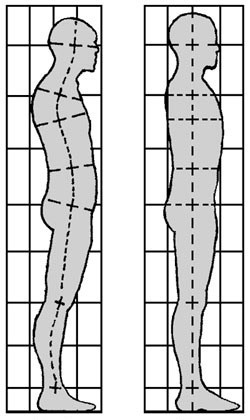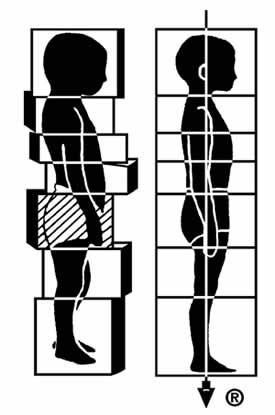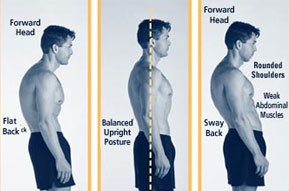The First Session
The intent of the first Rolfing session is considered superficial by most Rolfers, but they have a very special meaning for “superficial.” The session’s goal is to systematically release the body’s “stocking,” or the fascial sheath that lies just below the skin’s surface. Some lengthening of the trunk up and out of the pelvis is also anticipated, as well as a relaxation of the legs below the hip joint. Most people appear to be jammed into the pelvic structure from both above and below. After the initial session, clients usually feel longer and experience freer movement in the pelvis.
The breathing pattern of the client is also affected by this session. Most of us employ only the upper rib cage when we breathe instead of using the bottom of the cage and the diaphragm. By skillfully working with the superficial fascia as it spans the ribs, shoulder joint and costal arch, a Rolfer can help fashion a breathing pattern which uses the diaphragm and the front, sides and back of the rib cage to create one smooth, bellows like motion. As breathing becomes deeper and easier as the sessions go on, more oxygen is available for metabolic and catabolic activities, and the client feels an increase of energy.
The end of the first session involves some freeing of the fascial planes around the neck and shoulders, a lengthening of the structures on either side of the spine and those covering the lower back. Finally, the client is asked to walk and describe what changes he or she feels. Reports of a “lightness” and ease, and the strange sensation that one is taking up more space are common. Some kind of “homework” is usually assigned to reinforce the session’s results. The Rolfer might suggest the client imagine a string hanging from a helium-filled balloon and tugging on the top of his or head as he or she walks. Or the client might be told to allow his or her breaths to press against the sides of the ribs or to both rise toward the head and drop to the navel.
The Second Session
The second Rolfing session centers around the legs and especially the feet. Most people carry their weight on the outside edge of each foot, even though the inside appears better able to support the stresses of body weight. In addition, most people walk by allowing the legs to pull the upper body along after them. This habit puts too much pressure on the heels and can reduce flexibility in the toes and metatarsals. If, on the other hand, the upper body initiates a step by “falling” lightly forward, the legs can easily swing forward in response, the body’s weight “caught” on the whole foot. To teach this behavior, the second session begins with the feet.
After one leg has been worked with, clients are asked to walk and compare the action of the two legs. Invariably, they report that the leg, which has been Rolfed feels stronger, more secure. Often they notice that the weight travels on the inside of the Rolfed foot and that there seems to be less pressure on the heel. The other leg will then be Rolfed and some work done on the back and neck to complete the session.

The Third Session
The third Rolfing session is an integrating one. It attempts to tie the first two sessions together in a complex whole. It is the last of the “superficial” sessions and a crucial point for both Rolfer and client. If, for any reason, either one wishes to delay the series, it is advantageous to do so before the fourth Rolfing session, which begins to deal with the deep structures of the pelvis.
Fundamentally, the third Rolfing session deals with what’s called the “lateral line” from the head of the humerus, or upper arm, to the greater trochanter of the femur, or thigh bone. The client lies on his or her side as the Rolf practitioner works to arrange the shoulder, ribs and pelvis into an even stack. He tries to differentiate the rib cage from the shoulder girdle on top and the pelvis underneath. The Rolfer’s goal is to set each in its own space without crowding from its neighbors. The result will eventually be freer breathing and less painful crowding of the structures.
Typical homework after the third session might be to imagine that the pelvis is hanging from the rib cage like a swing hanging from a tree limb.

The Fourth Session
The fourth Rolfing session represents a change in the therapist’s intention and commitment. His or her focus is no longer on the superficial fascial planes and is now concentrated on what’s called the body’s “active core.” Rolfers define “core” structures as those that lie close to the spine and the body’s midline; they are differentiated from the “sleeve” consisting of the shoulder and pelvic girdles and the “lateral” structures of the legs.
The agenda for the fourth session is deceptively simple, and the session may actually take less time than those that come before. The inside of the legs, from the ankles to the pelvic floor, is treated, followed by work on the hamstring muscles and some “organizing” of the back and neck. The goal of the session is to establish improved support for the structures that make up the pelvic floor. Although most of the work is on the legs, a client will also often feel a “lift” throughout the torso. The fourth Rolfing session seeks to establish an inner pillar from which the limbs can be hung. That is, the Rolfer wants to hang the body’s “sleeve” from the supportive “core.
The Fifth Session
The fifth Rolfing session is a continuation of the fourth. It is recommended that not more than two or three weeks separate these sessions. It’s province is the relationship of the superficial abdominal muscle (the Rectus Abdominis) to the deep-seated hip flexor (the iliopsoas ). Most people wrongly use the wide band of external stomach muscles to do the work of the stronger, deeper-lying muscles. During this session the Rolfer slowly lengthens and separates the outer structures to allow room for the inner structures to reassert themselves.
Sometimes clients become anxious about this particular session, especially when they know a bit about anatomy. They fear manipulation deep in the body and in the area of crucial organs. However, Dr. Rolf discovered an ingenious and remarkably safe method of examining these deep structures with a minimum of discomfort. Only a properly trained Rolfer should attempt this method, but with the right education and experience, the fifth Rolfing session often becomes more enjoyable and produces less discomfort than those preceding it.
The deep stomach muscles have certain properties that make them unique in the body. They are the only muscles that extend from the legs to the trunk. All other muscles of the leg or trunk attach directly to some part of the pelvic girdle. As a result, the proper training and toning of these leg and stomach muscles are usually better for bad backs than traditional sit-ups.
In fact, sit-ups are likely to exaggerate back problems by shortening the front of the body from the collarbone to the hip joint. But the balancing exercises of Rolf movement work are designed to bring health and vitality to the under-used deep structures, and they can do much more than the surface muscles to cure weak backs.
A healthy, active psoas muscle also helps other conditions. The nerve fibers located near the psoas become stimulated as the muscles respond to new movement. Menstrual cramping, constipation and excessive gas are often lessened as a result. A satisfying feeling of the leg-trunk connection of these muscles often emerges as the client learns to move his or her legs from the lumbar spine rather than from the hip joint. The holistic nature of the body becomes physical reality rather than an intellectual idea. The “pelvic tilt” is sometimes taught during this session to give the client a way to practice moving with the psoas at home.
The Sixth Session
In the Rolfing series, each session focuses on some aspect of the pelvis. Even in the second session, work on the legs and feet is designed to establish support for the pelvic basin. However, the sixth session is very specific in its approach to the pelvis. The muscle structures that are the keys here are the deep rotating muscles under the buttocks. If the client’s legs are unable to function smoothly while walking, balancing the “rotators” deep in the buttocks will usually even out the operation.
By this time in the sequence, both the Rolfer and his client have become aware of the balancing of the pelvic structure. As the body becomes more symmetrical and organized around a vertical line, disparities between the right and left sides become less apparent. In the sixth session, this symmetry is enhanced and extended above and below the pelvic girdle.
The incorrect use of the term “posture” to describe the results of Rolfing can now be better understood. The Latin root of posture is “positus,” meaning “to place, to put.” Consequently, “good posture” usually implies the “placing” of the body into a position that is considered appropriate and balanced. The goal of the Rolf process in it’s sixth session, on the other hand, is to create a structure which rests on a well-supported vertical core and demands a minimum effort to maintain while the person is standing. Rolfing, therefore, is concerned with the integration of human structures and not with notions about posture.
The results of the sixth Rolfing session are generally dramatic and welcomed by clients. A sense of “bigness” and space are reported, as well as an ability to breathe through to the spine; that is, the spine appears to undulate during respiration in a wavelike motion. People who have decreased or eliminated chronic back pain through Rolfing usually point to the sixth session as pivotal in their progress. Others, who come suffering from anxiety, may also claim a great easing of emotional distress after this session.
The Seventh Session
Referring to the seventh Rolfing session, Dr. Rolf often remarked: “The seventh session is the last chance to ‘horizontal’ the pelvis,” but in fact, the work of the seventh session is directed entirely toward balancing the neck and head on the spine. During a seventh session, the Rolfer works on the fascia of the neck, opens the connective tissues around the skull and face and helps to improve breathing further by opening constricted nasal passages.

The Eighth, Ninth and Tenth Sessions
In each of the first seven sessions of Rolfing, the practitioner focuses on one area of the body. The goals of a particular session center around placing its part in the vertical balance of the whole body. With the eighth session, a broader and more comprehensive approach to the problem of integrating the entire structure becomes necessary. These last three sessions are called the “integrative hours,” and in them the client prepares to end his Rolfing series.
The dictionary defines “integration” as a ” combination and coordination of separate and diverse elements or units into a more complete and harmonious whole.” This is the job of the client and the Rolfer in these final sessions. “It is easy to take a body apart,” Dr. Rolf would declare, “but it takes skill and understanding to put it back together.”
In the last three Rolfings, the practitioner tries for a body that is poised on a narrow base and can move in any direction with equal ease. Large fascial sheaths are related one to the other, and a “silky” quality in the muscle tissue is sought. Several times during these sessions, the client will be asked to stand up and walk about in order to assess the result of the manipulations. Much work will be done with the client sitting or standing, because the relationship of a particular body part to gravity is the most important goal in these hours.
In these sessions, it is time to get the client ready to leave Rolfing, and it is suggested that he avoid more deep structural work for six months to a year after the initial series, because the change that is initiated by the first sessions will continue for months, even years, after the series is completed. During this fallow time, however, many clients see Rolf movement teachers who are trained to teach them ways of using their “new” bodies to maximum benefit. The Rolfed individual is encouraged not to lean on the Rolfer for further changes by his or her body but to look to the intelligence within it for new ways of using the initial changes.
Reprinted with the kind permission of Rodale Press, this article is from the book Whole Body Healing by Carl Lowe, James W. Nechas and the editors of prevention magazine. Copyright 1983 by Rodale Press, Inc.
For information about purchasing this book, you may contact your local bookseller or the publisher whose address is… Rodale Press Inc., 35 E. Minor Street, Emmaus, Pennsylvania 18049 USA

Beyond The Ten Sessions
Tune-Ups
After completing a basic series of Rolfing treatments, a client’s body will continue to undergo changes for up to 6 months. After this time we suggest you get a treatment of Rolfing ever 6-9 months. This will continue to keep your body in alignment. There are some things that may knock your body out of alignment such as: a car accident; a prolonged illness; gaining a great deal of weight in a short period of time; losing a great deal of weight in a short period of time; a pregnancy; an emotional trauma such as a death, a nasty divorce, a rape or mugging. Usually 1-3 treatments will realign the body. If this does not complete the realignment process an Advanced Series of Rolfing may be implemented.
Advanced Rolfing
After a Rolfer has been certified by the Rolf Institute and has worked as a Rolfing practitioner of Structural Integration for 3-7 years he must take his Advanced Rolfing training. This training allows the Rolfer to look and work outside of Ida Rolf’s basic Rolfing series framework if needed. Advanced Rolfing for a client may focus on a more chronic pattern of misalignment. Advanced Rolfing may work with a focus on movement patterns, breathing abnormalities, gait, flexibility, or any number of different problems within the body. Usually advanced Rolfing consists of less than ten treatments.
